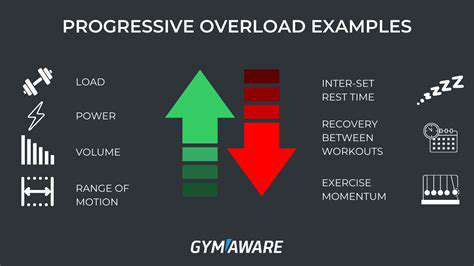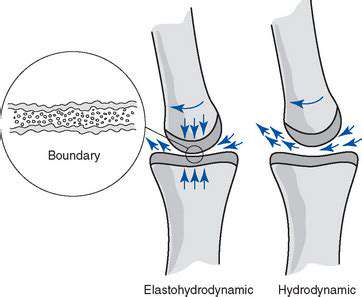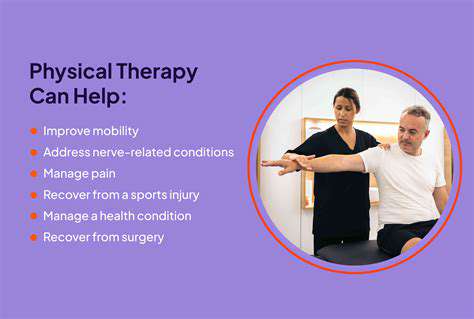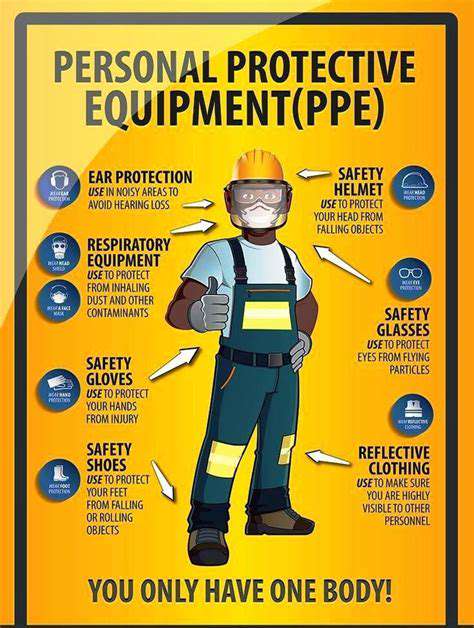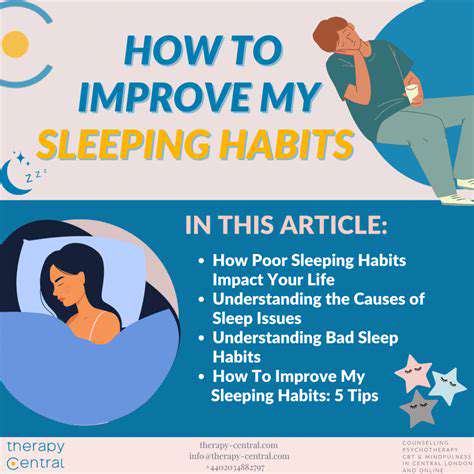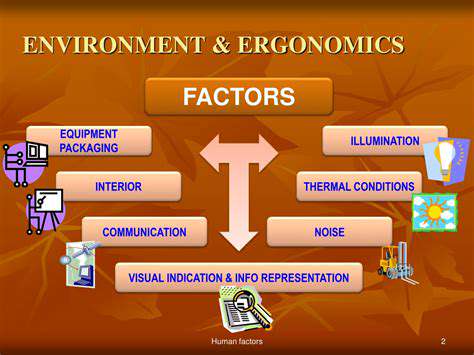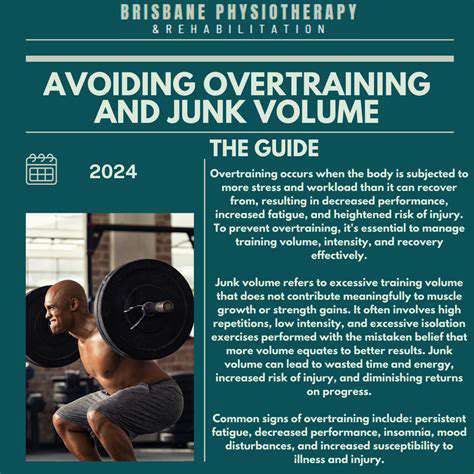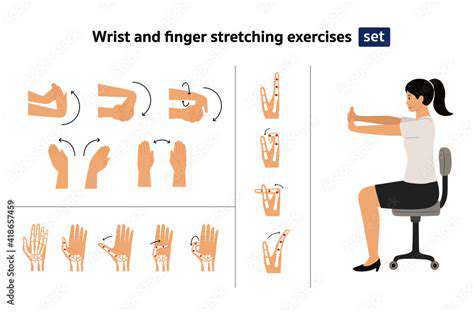Effective Strategies to Combat Repetitive Strain Injuries
Understanding Repetitive Strain Injuries
Repetitive strain injuries (RSIs) are a significant concern in today's world, impacting a wide range of professions and lifestyles. They occur when repeated motions or postures strain muscles, tendons, ligaments, and nerves over time. This sustained stress can lead to pain, inflammation, and reduced functionality. Understanding the underlying mechanisms behind these injuries is crucial for developing effective preventative measures.
Recognizing the subtle signs of strain is essential. Initial symptoms often go unnoticed or are dismissed as minor aches, leading to delayed treatment and potentially worsening conditions. Early intervention is key to preventing long-term issues and ensuring a swift recovery.
Posture and Ergonomics: The Silent Architects of Strain
Poor posture and inadequate ergonomic setups are frequently overlooked contributors to repetitive strain injuries. Maintaining a neutral spine alignment and ensuring that workstations are properly adjusted to accommodate individual needs are paramount. This includes adjusting chair height, desk placement, and monitor position to promote a comfortable and supportive posture throughout the workday.
The use of supportive equipment, such as ergonomic keyboards and mice, can significantly reduce the strain on wrists and hands. Furthermore, taking regular breaks to stretch and reposition the body can prevent the build-up of tension and stiffness.
The Role of Force and Repetition in Injury
The combination of forceful exertions and repetitive motions is a major risk factor for repetitive strain injuries. Tasks requiring excessive force, whether physical or applied through tools or equipment, put immense stress on the body's tissues. This stress, compounded by frequent repetition, leads to micro-tears and inflammation, ultimately resulting in pain and functional limitations.
Understanding the relationship between force and repetition is crucial for identifying potential risk factors in various work environments. Analyzing the specific actions and movements involved in a task can highlight areas where force and repetition are concentrated, allowing for targeted interventions.
Work Environment and Lifestyle Factors
Environmental factors, such as the temperature, lighting, and noise levels in a workspace, can also contribute to the development of repetitive strain injuries. Prolonged exposure to stressful environments can lead to increased muscle tension and reduced blood flow, compounding the risk of injury.
Lifestyle factors, including poor sleep habits, inadequate nutrition, and lack of exercise, can also weaken the body's ability to cope with repetitive stress. Maintaining a balanced lifestyle with sufficient rest, a healthy diet, and regular physical activity can significantly reduce the risk of developing these injuries.
Individual Predisposition and Risk Assessment
Individual predisposition to repetitive strain injuries can vary significantly based on factors such as pre-existing conditions, genetics, and individual physical characteristics. Some individuals may be more susceptible to injuries due to weaker tendons or ligaments, or a naturally higher level of muscle tension.
Understanding individual risk factors is crucial for personalized risk assessments. This approach involves evaluating individual job tasks, ergonomic setups, and lifestyle factors to identify specific areas of concern and develop targeted preventative strategies.
Ergonomic Adjustments for a Healthier Workspace
Adjusting Your Chair for Optimal Support
A properly adjusted chair is crucial for preventing back pain and promoting good posture. Ensure the seat height allows your feet to rest flat on the floor, with your thighs parallel to the ground. Adjust the backrest to provide lumbar support, cradling your lower back and preventing slouching. Experiment with different backrest angles to find the most comfortable and supportive position for your body type. Proper chair adjustment significantly impacts your overall comfort and productivity throughout the workday.
Screen Placement for Eye and Neck Health
Screen placement is paramount for preventing eye strain and neck pain. Position your monitor directly in front of you, at arm's length. This distance helps reduce eye strain and promotes good posture. Ensure the top of the screen is at or slightly below eye level. This prevents you from craning your neck forward, a common cause of neck pain and discomfort. Maintaining the correct monitor height is essential for long-term eye and neck health.
Keyboard and Mouse Positioning for Wrist Support
Positioning your keyboard and mouse correctly is vital for maintaining wrist health. Place the keyboard directly in front of you, and ensure your wrists are straight and aligned with your forearms. Avoid bending your wrists excessively when typing or using the mouse. A wrist rest can provide additional support and help maintain a neutral wrist position, preventing carpal tunnel syndrome and other wrist injuries. A comfortable and supportive setup is crucial for productive and pain-free work sessions.
Keyboard and Mouse Positioning for Wrist Support
The placement of your keyboard and mouse significantly influences your wrist health. Position the keyboard directly in front of you, ensuring your wrists remain straight and aligned with your forearms. Avoid extreme bending of the wrists while typing or using the mouse. Using a wrist rest can provide additional support, fostering a neutral wrist posture and helping prevent carpal tunnel syndrome and similar wrist injuries. This approach reduces strain and promotes a healthier work environment.
Monitor Arm and Multi-Monitor Setup
Using a monitor arm or arranging multiple monitors effectively is key to a healthy workspace. Monitor arms allow for adjustable height and angle, enabling you to position screens at the optimal distance and angle for your eyes and neck. If using multiple monitors, arrange them strategically to minimize reaching and twisting. Ensure proper spacing between monitors to prevent eye fatigue and maintain a comfortable viewing experience. Optimal monitor placement is essential for long-term visual health and productivity.
Proper Workstation Layout for Movement and Breaks
A well-organized workspace allows for easy movement and regular breaks. Ensure your workspace is clutter-free, with essential items readily accessible. Keep frequently used items within easy reach to minimize unnecessary movements and strain. Plan regular breaks to stand up, stretch, and walk around to improve circulation and reduce muscle stiffness. A well-organized workspace promotes both physical and mental well-being.
Importance of Regular Breaks and Movement
Regular breaks and movement are crucial for maintaining focus and preventing fatigue. Schedule short breaks every hour to stand up, walk around, and stretch. These breaks help improve blood circulation, reduce muscle stiffness, and prevent stiffness and pain. Engaging in light exercises during breaks can also enhance focus and productivity. Regular movement and breaks promote overall well-being and productivity, combating the negative impacts of prolonged sitting.
Preventive Measures: Building a Robust Defense

Understanding the Foundation
A robust preventative strategy for any risk, including those related to a project, requires a deep understanding of the underlying factors contributing to the problem. This involves identifying the root causes of potential issues, analyzing historical data, and recognizing patterns that might indicate future problems. Thorough research and meticulous investigation are essential to building an effective preventive framework.
A critical component is accurately assessing the potential impact of each identified risk. This involves considering the probability of the risk occurring and the severity of the consequences if it does. This step is crucial for prioritizing preventative measures and allocating resources effectively.
Proactive Risk Identification
Proactive risk identification is not just about anticipating problems; it's about actively seeking them out. This involves engaging stakeholders from different levels of the project, encouraging open communication, and fostering a culture where people feel comfortable reporting potential issues or concerns. This collaborative approach will often reveal risks that might otherwise go unnoticed.
Regular reviews and assessments are vital to maintaining a proactive stance. These reviews should identify emerging trends and potential new vulnerabilities. This proactive approach ensures that preventive measures remain relevant and effective in the face of changing circumstances.
Implementing Robust Preventive Controls
Implementing effective preventive controls requires a multi-faceted approach. This includes developing clear and concise policies, procedures, and protocols that outline the steps to be taken to mitigate identified risks. These documents should be easily accessible and understood by all relevant personnel.
Moreover, consistent training and education for all personnel is essential. This ensures that everyone is aware of the preventive measures and understands their roles in maintaining a safe and efficient operation. This ongoing education helps employees to develop the necessary skills and knowledge for effective risk mitigation.
Monitoring and Evaluation
Monitoring and evaluation are crucial for ensuring that preventive measures are effective and remain relevant over time. This involves regularly assessing the performance of the implemented controls, identifying any weaknesses, and making necessary adjustments. This continuous feedback loop allows for refinement of preventive strategies to maintain their effectiveness.
Regular reporting and analysis of monitoring data are essential for understanding the effectiveness of the preventative measures. The data collected should help identify trends and areas for improvement, allowing for necessary adjustments to the preventive measures.
Adaptability and Refinement
The world is constantly changing, and so too are the risks and threats that need to be addressed. A dynamic, adaptable approach to preventive measures is critical. This means regularly reviewing and updating preventive strategies to account for new information, emerging trends, and changing circumstances.
This continuous process of review and refinement is essential for ensuring that preventive measures remain relevant and effective. This adaptability is key to ensuring the long-term success of any preventative strategy.
Effective Treatment Strategies: Addressing the Issue Directly

Pharmacological Interventions
Pharmacological interventions play a crucial role in managing various aspects of the condition. These interventions often target specific symptoms and underlying mechanisms. Medication selection is highly individualized, considering factors such as severity, co-occurring conditions, and patient response. A comprehensive assessment by a qualified healthcare professional is essential to determine the most appropriate and effective pharmacological approach. This often involves a trial-and-error process to find the optimal medication and dosage for each patient.
Different classes of medications may be used, each with its own potential benefits and side effects. For instance, some medications focus on reducing inflammation, while others target neurotransmitter imbalances. Careful monitoring of the patient's response to medication is crucial to ensure safety and effectiveness. This involves regular check-ups, blood tests, and assessments of symptom improvement.
Non-Pharmacological Therapies
Non-pharmacological therapies are often integrated with pharmacological interventions to provide a holistic approach to treatment. These therapies aim to address the physical, emotional, and social aspects of the condition, fostering overall well-being. They can significantly enhance the effectiveness of pharmacological interventions and contribute to improved quality of life.
Examples of non-pharmacological therapies include lifestyle modifications, such as dietary changes, exercise regimens, and stress management techniques. These strategies can contribute to symptom reduction and overall health improvement. For instance, regular exercise can improve mood and reduce anxiety, while a balanced diet can provide the necessary nutrients for optimal bodily function.
Psychological therapies, such as cognitive behavioral therapy (CBT), can also be very beneficial. CBT helps patients to identify and challenge negative thought patterns and behaviors that may be contributing to the condition. This approach can equip patients with coping mechanisms and strategies for managing stress and triggers. Furthermore, support groups and counseling can offer valuable social support and emotional guidance.
Complementary and Alternative Medicine
Complementary and alternative medicine (CAM) approaches, such as acupuncture, herbal remedies, and mindfulness practices, are sometimes considered alongside conventional treatments. These approaches may offer additional support in symptom management, but it's crucial to consult with a healthcare professional before incorporating CAM therapies into the treatment plan. The safety and efficacy of many CAM therapies are not fully understood, and they may interact with conventional medications.
While some individuals find relief through CAM, it's important to remember that these approaches are not always scientifically proven. Rigorous research is necessary to fully evaluate the effectiveness of these interventions, and their integration into a treatment plan should be carefully considered in consultation with a healthcare professional.
Lifestyle Modifications and Long-Term Well-being
Prioritizing Balanced Nutrition
A crucial aspect of achieving long-term well-being is focusing on a balanced and nutritious diet. This involves incorporating a variety of whole foods, including fruits, vegetables, lean proteins, and whole grains. A balanced diet not only provides essential nutrients for optimal physical health but also contributes significantly to mental clarity and emotional stability. Avoiding processed foods, sugary drinks, and excessive saturated fats can make a substantial difference in overall energy levels and mood regulation, ultimately promoting a healthier lifestyle. Sustained consumption of nutrient-rich foods fuels the body effectively, improving resistance to illnesses and supporting overall vitality.
Furthermore, mindful portion control plays a vital role in weight management and maintaining a healthy body composition. Understanding your body's individual needs and adjusting portion sizes accordingly is key to preventing overeating and promoting a positive relationship with food. Paying attention to hunger and fullness cues can also enhance this process, allowing for a more intuitive and personalized approach to eating habits. This conscious approach to nutrition is a cornerstone of long-term well-being, setting the stage for sustainable healthy habits.
Incorporating Regular Physical Activity
Regular physical activity is indispensable for maintaining both physical and mental well-being. Engaging in activities like brisk walking, jogging, swimming, or cycling, even for moderate durations, can significantly improve cardiovascular health, boost energy levels, and contribute to weight management. Beyond the physical benefits, regular exercise has a profound impact on mental health, reducing stress, anxiety, and symptoms of depression. Finding activities you genuinely enjoy is key to making exercise a sustainable part of your routine, rather than a chore.
Consistency is paramount in reaping the rewards of physical activity. Establishing a routine that fits your schedule and lifestyle is key to long-term adherence. This could involve incorporating short bursts of activity throughout the day, or dedicating specific times for more extended workouts. Even small changes, such as taking the stairs instead of the elevator or walking during your lunch break, can accumulate into significant improvements over time. Finding an activity you enjoy and that fits your lifestyle is essential to maintaining a consistent routine and reaping the benefits of regular exercise.
Cultivating Stress Management Techniques
Managing stress effectively is crucial for long-term well-being. Chronic stress can negatively impact physical and mental health, leading to various ailments. Implementing stress management techniques, such as mindfulness practices, meditation, or deep breathing exercises, can help mitigate the negative effects of stress. These techniques promote relaxation, reduce anxiety, and improve emotional regulation, ultimately contributing to a more balanced and peaceful state of mind.
Beyond these formal techniques, engaging in activities you find enjoyable and relaxing can also be a powerful stress reliever. Whether it's spending time in nature, listening to music, pursuing a hobby, or simply engaging in a relaxing conversation with loved ones, finding healthy outlets for stress reduction is key to maintaining a positive outlook and overall well-being. The key is to identify and implement strategies that work for you, creating a personalized toolkit for managing stress effectively.
Prioritizing Sufficient Sleep
Adequate sleep is fundamental to overall well-being, impacting both physical and mental health. Insufficient sleep can lead to reduced cognitive function, impaired mood regulation, and increased susceptibility to various health problems. Establishing a regular sleep schedule, creating a relaxing bedtime routine, and ensuring a conducive sleep environment are essential for promoting quality sleep. A consistent sleep-wake cycle helps regulate the body's natural sleep-wake rhythm, promoting better sleep quality and overall well-being.
Creating a sleep-conducive environment involves minimizing distractions and ensuring a comfortable temperature in the bedroom. Reducing exposure to screens before bed and avoiding large meals or caffeine close to bedtime can also significantly improve sleep quality. Prioritizing sufficient sleep is not just about the number of hours but also the quality of sleep, which directly influences our ability to function optimally throughout the day and maintain our overall well-being.
